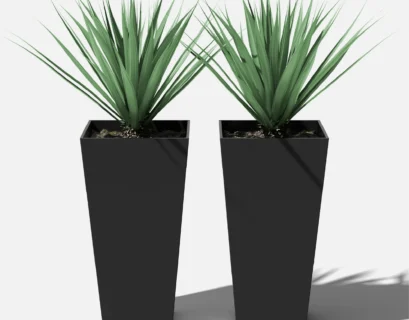When caring for our plants, finding the right balance between convenience and sustainability is essential. Self-watering planters have been praised for catering to busy plant owners, yet some criticize their environmental impact. Are these planters truly eco-friendly, or do they harm the planet in ways we may not see?
The Rise of Self-Watering Planters
Before we delve into the eco-debate, let’s take a moment to appreciate the ingenuity behind self-watering planters. SproutFolk, your go-to hub for all things green, has been exploring this burgeoning trend with fervor. From our in-depth guides like “The Ultimate Guide to Self-Watering Planters” to practical tips for travelers in “Self-Watering Planters for Travel Lovers”, we’ve left no leaf unturned.
Self-watering planters offer a lifeline for those who struggle to maintain a consistent watering schedule or find themselves jet-setting more often than not. With built-in reservoirs that supply water to the soil as needed, these ingenious creations promise to keep our beloved greenery lush and thriving, even in the midst of our chaotic lifestyles.
Water Conservation: A Silver Lining?
One of the most touted benefits of self-watering planters is their potential to conserve water. In a world where every drop counts, the ability to minimize water waste is nothing short of revolutionary. Traditional watering methods often result in excess moisture trickling out of the drainage holes, leaving both plants and the environment parched for resources.
With self-watering planters, however, water is delivered directly to the plant’s roots, reducing the risk of evaporation and runoff. As highlighted in “The Science Behind Self-Watering Planters”, these containers utilize capillary action to draw water upward, ensuring that every drop is put to good use.
“Self-watering planters serve as champions of water conservation, offering a glimmer of hope in our quest for a greener tomorrow.” – SproutFolk
But before we christen them as saviors of the aqua realm, it’s essential to consider the full picture. While self-watering planters undeniably excel in water efficiency, their eco-friendliness extends beyond mere hydration.
Stay tuned as we explore the flip side of the coin, uncovering the potential pitfalls lurking beneath the glossy surface of these modern marvels. Are self-watering planters truly the green solution we’ve been searching for, or do they come with a hefty environmental price tag? Join us as we navigate the verdant landscape of sustainable gardening, one drop at a time.
The Plastic Predicament
As we bask in the convenience of self-watering planters, it’s easy to overlook a glaring concern: plastic pollution. While these planters may save water, many of them are predominantly made from plastic materials. As explored in “Self-Watering Planters vs. Traditional Pots”, the prevalence of plastic in modern gardening equipment raises eyebrows among eco-conscious consumers.
Plastic, notorious for its non-biodegradable nature, poses a significant threat to our environment. From clogging our oceans to infiltrating our soil, its pervasive presence demands a reevaluation of our consumption habits. Despite their water-saving capabilities, self-watering planters contribute to the plastic influx, perpetuating a cycle of waste that challenges their eco-friendly image.
“In the battle against plastic pollution, every choice we make – from the products we purchase to the materials we use – carries weight. Are self-watering planters unwitting accomplices in this environmental crisis, or can they evolve to embody true sustainability?” – SproutFolk
SproutFolk engagement against global warming
Seeking Sustainable Solutions
Amidst the plastic predicament, hope springs eternal in the realm of sustainable gardening. As advocates for green living, SproutFolk is committed to exploring alternative materials and practices that prioritize both planet and plant. In “DIY Self-Watering Planter Project”, we empower readers to craft their own eco-conscious planters using recycled materials and ingenuity.
But the quest for sustainability doesn’t end there. In “Creating a Beautiful Indoor Jungle with Self-Watering Planters”, we delve into the art of pairing self-watering planters with air-purifying houseplants, forging a harmonious sanctuary that nurtures both body and soul. By selecting plant species that thrive in low-maintenance environments, we minimize water consumption and plastic waste without compromising on greenery’s aesthetic allure.
The Verdict: Finding Balance
So, are self-watering planters truly eco-friendly, or do they fall short of their green aspirations? As with all things in life, the answer lies in balance. While these innovative containers offer undeniable benefits in water conservation and plant care, their reliance on plastic materials raises valid concerns about sustainability.
As conscientious stewards of the earth, it’s imperative that we approach gardening – and life – with a holistic perspective. By embracing practices that prioritize both environmental health and plant well-being, we can cultivate a greener future for generations to come. So whether you opt for self-watering planters, traditional pots, or DIY creations, remember: every choice has the power to shape our planet’s destiny. Let’s choose wisely, and together, we can nurture a world where nature thrives and plastic fades into obscurity.











